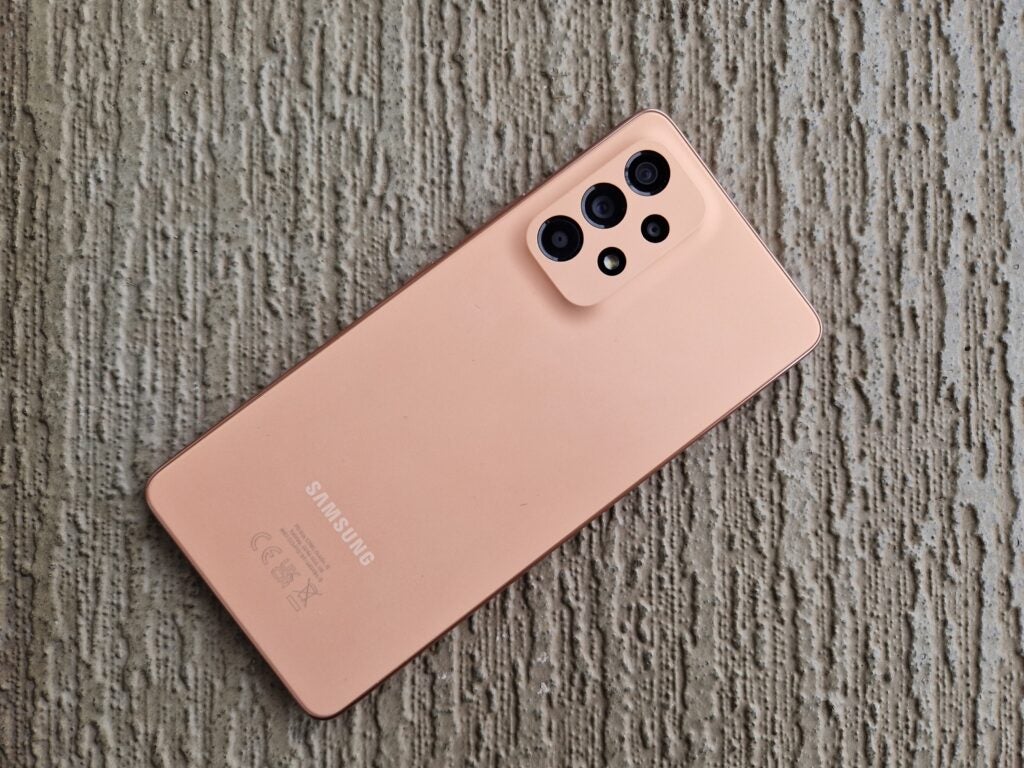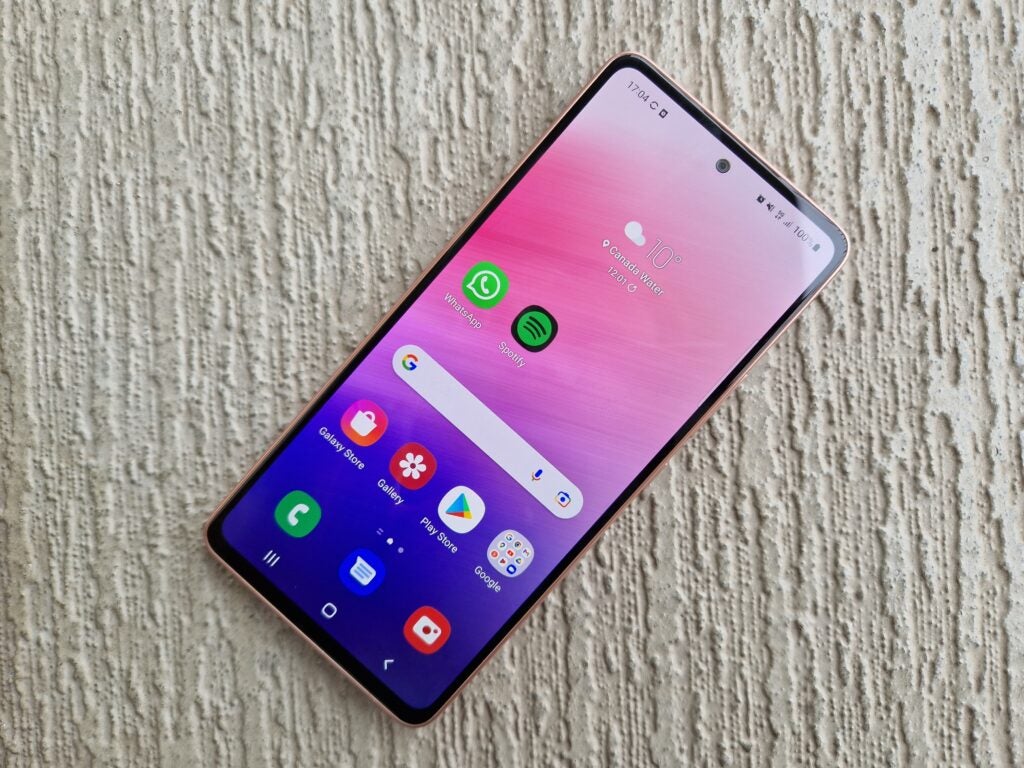Verdict
The Samsung Galaxy A53 5G is an impressive device for the price, offering many high-end features in a cheaper body. That isn’t to say sacrifices haven’t been made, though.
Pros
- Great screen for video
- Decent battery life
- Good camera system
- Fairly attractive design
Cons
- No adaptive refresh rate
- No wireless charging
- No charger included in the box
- No 3.5mm headphone jack
-
5G supportThis phone will support 5G networks for faster download speeds in certain areas -
Excellent screenFor the price, the 6.5-inch OLED display offers plenty of features including a 120Hz refresh rate for smooth scrolling, a decent brightness range and an in-display scanner -
Nice designSmooth back panel, three colour options and an IP67 rating
Introduction
While Samsung is best known for its flagship S series, led by the Samsung Galaxy S22 Ultra this year, much of its sales volume actually comes from its vast range of affordable A series phones, which offer a lower entry price for consumers who still want to stick with Samsung.
The Galaxy A53 5G is firmly in the mid-range of modern smartphones, which is to say that while it does not boast all the headlining features boasted by the most impressive flagship phones it does still offer a balance of performance with affordability – in this case a 120Hz 1080p AMOLED display, a 5000mAh battery, and a 64-megapixel lead camera sensor.
Read on for our assessment on whether the overall package is a worthy compromise.
Design and Screen
- Attractive, though plastic, design
- IP67 rating
- No 3.5mm headphone jack
- Good screen quality
The Samsung Galaxy A53 5G has an appealing design that’s not too flashy. The rear panel has a pleasing matte finish that is impervious to fingerprint smears and also feels comfortable to the touch, not being slippery or overly plasticky.

The camera module is housed in a gently raised bump that’s a little reminiscent of the Oppo Find X5 Pro, and is similarly good-looking based on my experience using the two. The shiny sides and flat screen may recall the Samsung Galaxy S22 Plus, though this device is made in plastic rather than metal and glass. My review unit is in “Awesome Peach”, though there are three other “awesome” colours to choose from. These include Awesome Blue (which is similarly a pastel shade), Awesome Black, and Awesome White.
Fortunately it’s not just handsome but practical too, with an IP67 rating, a certification often lacked by competitor devices, that provides a strong assurance against water or dust ingress. You can also add additional storage via a Micro SD card, though it does lack a 3.5mm headphone jack which is a bit of a shame for a mid-range device such as this one, since it nudges the user towards buying Bluetooth headphones.

Display quality is very often a highlight among Samsung devices, and this one is no exception to that rule. The Galaxy A53 5G’s screen is one of the best you’ll find at this price point. It has a 120Hz maximum refresh rate, which makes scrolling far smoother than competitors at 60Hz or 90Hz, while the 1080p resolution is plenty sharp enough. It’s large too, measuring in at 6.5-inch diagonally across. Moreover it is cat in Gorilla Glass 5, so it should offer significant resistance to the bumps or scuffs that any smartphone screen is exposed to in daily usage over time. I haven’t drop tested the phone, but using it for over a fortnight the handset remains in pristine condition.
Despite the fact that it lacks HDR support, it’s still enjoyable to watch movies or TV shows on Netflix with this handset, as it is sharp and smooth while the small pinhole notch for the selfie camera offers minimal interruption.
Camera
- Good results overall, though quite saturated
- Main sensor is the best by far
The camera set-up looks fairly promising from the specs sheet. Led by a 64-megapixel main camera sensor with an f/1.8 aperture, there are three accompanying lenses including a 12-megapixel ultrawide lens, a 5-megapixel macro camera, and a 5-megapixel depth sensor.
Below is a selection of shots from the main camera:




One of the first things you’ll probably notice about the camera is just how vivid the colours are. This is quite common amongst Samsung phones, though I feel it’s even stepped up a notch here, with greens and blues looking especially lurid. This effect is often desired for platforms such as Instagram, and the punchy look is often quite widely liked, but if you want more natural colours then this might not suit your sensibilities. If that’s what you’re after we’d suggest looking at the Pixel 6, which offers far more natural results, based on our tests.

Unlike its more expensive siblings, there’s no zoom telephoto lens for a closer look at your subject. If you want to capture objects in the distance, instead you’ll have to count on the digital zoom capabilities. Normally this would be an issue in our experience most digital zoom solutions, which see you just crop and zoom into the main image being captured, yield pixelated results. But when I used the 2x digital zoom I was pleasantly surprised by the results, as you can see in the image above, which retained plenty of detail, so I don’t think you’ll feel let down by the lack of another lens.

Ultrawide images are not quite as sharp as those from the main sensor, but fortunately I found that colour grading between the two lenses was not jarringly different, as can sometimes be the case, so it’s a good addition to your options if you want to cram more into the frame of your picture. The above picture was taken with the ultrawide and the below was taken with the main camera from the same position, for a clear comparison of the two.

When you’re shooting in low light conditions with the main camera, you’ll notice that Night Mode does restore some amount of colour and detail to the images, though it’s not as impressive as the results you’ll get on the Google Pixel 4a for instance:

Macro sensors are quite often derided for being useless; as you can see from the result below this one is fine, but frankly it rarely comes in handy and should not make a great deal of difference in whether or not you choose to buy this phone.

When you’re shooting video with the main camera you’re able to get 4K footage at 30fps, or 1080p footage at 60fps. Footage is decent but not brilliant, and it does best in favourable daylight conditions although it did yield usable, albeit somewhat grainy, results even in the challenging conditions of a dark concert venue with flashing strobe lights.

The selfie camera performed well in my experience, admirably accentuating details in hair while also cutting around the subject very efficiently for a strong bokeh effect. Colours are far more gentle here too, which I appreciated.
You’ll notice when you boot up Portrait Mode, either with the selfie camera or the rear-facing camera, that it will pop up with a handy bokeh effect slider that allows you to control just how blurred the background is with an easy swipe of the finger.
Performance
- Decent performance levels
- 5G connectivity
The Samsung Galaxy A53 5G is a solid performer, but you won’t get exceptional standards from it. Again, this is a compromise that you would generally have to accept at the mid-range price point, and you may well accept that it’s worth the improvements in the screen and camera.
Below you can see the performance benchmarks for the device, compared against its peers. The Geekbench scores reflect its CPU performance, which is for general purpose tasks on the phone, and the 3DMark score is for the GPU, which concerns graphics and is particularly pertinent for gaming.
As you can see, it performs reasonably well against competing devices such as the Realme 9 Pro Plus and the Poco X4 Pro 5G. You won’t be able to squeeze superb gaming performance out of it, but it will do fine on lower settings, as I found in my experience. Unfortunately though, I did experience some juddering and lag when switching between different apps from time to time, which made for a less than perfect user experience.
Evidently, given the name, you’ll also get 5G connectivity, so you can get fast mobile data speeds depending on how widespread network coverage is in your area. The device also has dual-band Wi-Fi, and Bluetooth 5.1 connectivity (which will no doubt be useful as there is no 3.5mm headphone jack, so wireless Bluetooth headphones are likely to be your best option for audio).
If you’ve used a Samsung phone before, then the software will be familiar. This one has the brand’s OneUI 4.1 user interface overlaid on Android 12. There are quite a few pre-installed apps upon start-up – though you might appreciate some, such as Samsung’s own browser – and it also gives you access to useful features like Samsung Pay, and less useful ones like Samsung’s Bixby smart assistant. Overall it’s a decent enough software skin, and certainly preferable to those from rivals such as Xiaomi which include unwanted adverts.
In a step I’d like to see copied across the sadly neglected mid-range sector, this handset actually offers decent long-term software support. The Galaxy A53 5G has been promised OS updates for four years, and most importantly of all, security updates for five years. While even these guarantees fall short of Apple’s software support, it’s still a bold step in the right direction that means you can count on this phone for up to five years after your purchase. Most Android phones at this price don’t get more than a couple of years of support, by comparison.
Battery Life
- Good battery life
- No charger is included in the box
Of Samsung’s recent S22 flagship devices, we’ve pinpointed the battery as a weak spot that needs some improvement. However, it’s fortunate that this shortfall has not been replicated across the brand’s mid-range devices.
The Galaxy A53 5G’s battery is rated at 5000mAh, and it makes good use of that generous capacity. Over the course of the day I used it quite intensively, with five and a half hours of screen-on time, before it needed to be charged. When streaming Netflix for one hour, it lost 7% of its battery.
Another thing to note is that there is no charging brick included in the box. While this has been the case with Samsung’s flagships for a couple of years, I was a little surprised to see this measure applied to a mid-range device, as most of these are still supplied with chargers. Samsung’s ostensible reason to cut down on tech waste and therefore benefit the environment, but you are undeniably getting less for your money than you would otherwise, and may have to spend extra for a suitable charger.
The phone is rated at 25W fast-charging, and in my experience this took about one hour to charge the phone from 50% to full. This is good enough, but it’s worth bearing in mind that similarly-priced devices such as the OnePlus Nord CE 2 5G offer far greater fast-charging speeds. This handset is also incapable of wireless charging, though this is somewhat typical for the price.
Should you buy it?
If you’re looking for a mid-range all-rounder, that is attractively designed, with good performance levels, a pleasing screen, and a decent camera.
If you want the kind of high performance or excellent camera quality that you’ll only find on the best flagship phones around.
Final Thoughts
The Samsung Galaxy A53 5G delivers strong performance all-round, especially with its smooth and sharp screen and capable main camera. What’s more, it also delivers in a few areas that are often neglected in other mid-range phones, such as with an IP67 rating, and guaranteed long-term software support.
If you’re shopping around at this price point then this device is definitely a great contender to consider, but if you want top-quality results then you’ll have to fork out a bit more money for a more capable handset.
FAQs
No, it does not have a 3.5mm headphone jack
Yes, it does have 5G connectivity that you can access with a compatible SIM card and depending on network coverage
It’s available in four colours: Awesome Blue, Awesome Peach, Awesome Black, and Awesome White
Jargon buster
OLED and AMOLED
Types of displays that use self-lighting pixels to provide greater contrast and more vibrant colours than a typical LCD display, as well as sharper blacks.
5G
Offering faster download and upload speeds when compared to 4G. Great for game streaming and HDR video playback. Not supported everywhere yet and speeds vary wildly.
USB-C
The modern USB connector you’ll find on most Android phones, new laptops, cameras and games consoles. It’s reversible and used for charging along with data-transfer.
IP rating
An abbreviation for ‘Ingress Protection Code’, which lets you know to what extent a device might be waterproof or dustproof.
Refresh Rate
The number of times the screen refreshes itself per second.
















